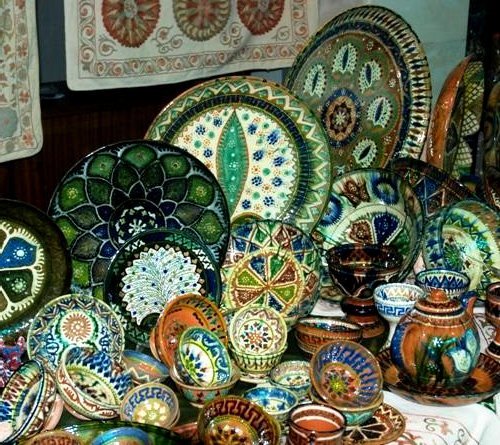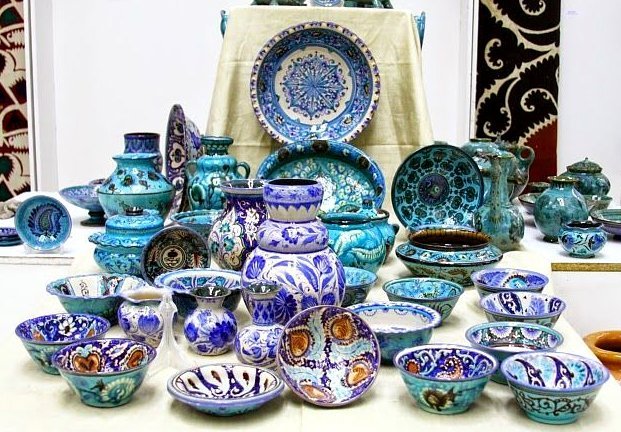Rishtan handmade Ceramics
A small town in the Fergana Valley has glorified these places all over the world. Rishtan became the center of Handmade pottery, and Rishtan blue ceramics are known today in all corners of our vast planet.
The production of pottery began in ancient times, the stages of its development until the middle of the nineteenth century have yet to be studied by archaeologists. Historians refer to the beginning of the production of pottery to the XII century. Separate sources testify that two centuries earlier pottery made of clay was made here, and the beginning of the industry was connected with the relocation of Bukhara and Samarkand masters to Rishtan, in these cities pottery production flourished in those days. The hypothesis that the Rishtan school could have arisen and get a rapid development on the basis of the existing ones is explained by the proximity of the Great Silk Road, whose routes eventually shifted northward and passed through the settlements of the Fergana Valley. Despite the endless raids of nomadic tribes, at the turn of the 9th century, the demand for glazed dishes and tiles increased significantly, as a result, new centers of pottery production arose. Historians agree that the rishtan pottery was influenced by the work of Chinese masters of the Ming period. Porcelain dishes, painted with cobalt, brought to these places, enjoyed constant demand.
The grace of the forms, the smooth lines of the pitchers and the vases that descended from the potter’s wheel, are typical of the whole of Central Asia. However, in the painting of Uzbek dishes, local residents managed to bring their own understanding of beauty. The variety of floral ornaments, the color spectrum, manifested by all shades of azure with impregnations of noble turquoise under a barely perceptible, thin layer of glaze – these are the distinctive features of utensils of incredible beauty. Exquisite blue and white fringe delicately shades the blue of the product.
Beautiful Rishtan Ceramics
At the end of the century before last, about eight dozen workshops were working in the city, at least three hundred people were engaged in industry. The pottery settlement was located in one of the districts of modern Rishtan. As a rule, the owner, all members of his family and several apprentices were involved in production. For a season that lasted about six months, more than 1,500 items were produced in one workshop. At that time the rudiments of guild production were born. One master worked on a single product or performed a specific operation, only in this case the artisan acquired the skill brought to the automatism and could perform his work with almost closed eyes.

Between the two directions of Rishtan ceramics there was a clear distinction, some masters made ordinary pottery, others – glazed. Craftsmen who produced voluminous vessels – kumas, huzes and other utensils for the kitchen, ovens for baking cakes – tanuras, called kuzagary and tanurchi. Occasionally in the production they used to glaze their products, but they considered it superfluous. Representatives of a different direction of artisans who produced a smooth, shiny, elegant decorated tableware were called tavokchi.
The shops had their own statutes and a heavenly intercessor – the aksakal was elected by a majority of votes. Representatives of both directions lived in their neighborhoods – mahallas. There was competition between the Kuzagars and the Tavokchis. Kuzagars believed that they were the bearers of the centuries-old tradition of pottery, while the Tavokchis, who looked down on competitors, looked down on the idea that their products were the top of perfection, because the demand for painted dishes sometimes exceeded the offer.
Comprehension of the secrets of mastery by Kuzagars was carried out in shorter periods in comparison with competitors. This is understandable, because the dishes with the glaze applied – it’s not just the potter’s skill, the main thing here is painting and applying glaze. Such utensils are produced as if in two stages, and the Kuzagars own only the first, but the rules for drawing an ornament, choosing a color scheme and making and applying watering, with observance of all the subtleties of technology, it needs to be trained for more than one month. Tavokchis, in order to avoid the emergence of competitors, did not admit unfamiliar people to their secrets, and only trained family members.

In the mid-nineteenth century, the characteristics and traditions of the Rishtan ceramics school, with which we are familiar today, were fully formed. One of the first copies of local dishes were Kabudi Misin, made in a turquoise color scheme with splashes of copper. Mastery of potters grew and they learned to make wonderful wares of faience with the finest lace painting, covered with turquoise glaze, such utensils called chinni. After the lapse of centuries, the technology of their manufacture was lost, and it was restored only thanks to the enthusiasm of the masters Abdul Jalol and Abdul Jamil Usto who obtained the techniques in Kashtar and Iran.
In parallel with Chinni, the production of Lojuvari – an utensil with ultramarine painting, was developed along a white background, covered with a delicate and glossy glaze with a matte surface. The technology of Ishkor was imported from Iran and Samarkand. The issue of dishes was concentrated in the ancient capital of Fergana, Akhsiket. Gradually, production spread to all the centers of pottery in Central Asia. In the XII century imitation dishes from China were particularly popular, under the irrigations of all shades of green, from saturated dark green to turquoise.
The blue ceramics of Rishtan were supplied to all major centers of Uzbekistan. In terms of quality, it was not inferior to the Chinese, but it was much cheaper, in addition, the color of turquoise, revered and widely distributed in the East (remember the mosques of the legendary Registan Square), smooth curves and skillfully applied traditional floral ornament allowed very quickly to win the hearts of admirers of exquisite dishes.
In rishtan ceramics there were still some elements of copying Chinese porcelain. By that time, supplies from the Celestial Empire had already been suspended, some wicked masters, knowing that the buyer highly appreciated Chinese-made utensils, put a brand on the bottom with Chinese hieroglyphs. Such dishes were called elgon chinni, chinni muslimi – imaginary or Muslim porcelain.
Not so popular was rishtan ware with a coating of liquid clay (an engobe), successfully hiding roughness, which was subsequently covered with glaze and painted with bright patterns in golden color. Such shades were obtained due to the addition of malgash (antimony oxide). Manufacture of such products was carried out by masters, who carried the honorary title of Usto – the teacher.
The names of many talented masters are included in the treasury of national art, so Usto Abdullah made tiles for the luxurious palace in Khudoyar Khan in Kokand, his pupil Usto Madamin Ahun, the couple of Usto Niyazmatovs, husband is the virtuoso of pottery, his wife is a talented artist.
Since the end of the ХІХ century Rishtan ceramics successfully began to conquer the Russian market. In 1900 it became a full-fledged exhibit of the World Exhibition in Paris. Specialists compared it to the best specimens of European majolica and were unanimous in the opinion that it would successfully compete with them.
Today, the specimens of Rishtan ceramics of those years that have survived in our museums of the Republic of Uzbekistan are impersonal, there is no possibility to determine their belonging to this or that master. Researchers are unanimous in their opinion, Rishtan became the starting point of the art of ceramics in Uzbekistan. However, under the influence of various factors, gradually the production in all centers of potter’s art began to fade, skills and unique technologies were lost. At the end of the ХІХ century a railway line from Tashkent to Fergana was put into operation, after which Russian manufacturers began to import factory crockery, conquering local markets.
Unable to withstand the confrontation with the artels, many handicraft workshops began to close, and yet the masters preferred to work individually, and not to join the artel, as required by the realities of the new era when the Soviet government came to the republic.

In 1918, 70 local potters united in the artel “Chinnigaron”, they were all hereditary craftsmen who owned all the subtleties of craftsmanship. The creative biography of many old masters is closely connected with this artel. By the beginning of the 1940s in Rishtan there were practically no artisans who worked individually. During the war, dozens of young potters went to the war and did not return. In those days the artels forgot about creativity and were engaged in the production of low-grade utensils.
The release of ultramarine ceramics ceased in the 30s. The masters of the older generation left the life, and along with them the secrets of the technology of its production.
In the times of the USSR the craftsmen of the Rishtan porcelain factory were not particularly creative. Plans and a range of products were launched from the top, officials sitting in the ministries believed that they knew better than to engage in such enterprises.
And only with the attainment of independence, enthusiasts of pottery art Rishtan took up the restoration of lost traditions and creatively apply them in modern conditions. Today Rishtan ceramics are on the rise again. Numerous tourists who are in Uzbekistan, with pleasure take with them the creations of skillful hands of masters.

